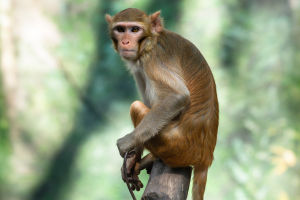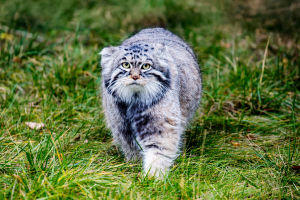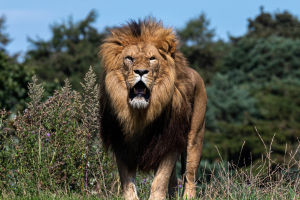
We're all curious about monkeys – they share a lot of traits with us humans, but they also have some fascinating and unexpected behaviors. Let's dive into 15 fun and surprising facts about monkeys that will definitely make you see them in a whole new light.
Get ready, Lykkers, we're about to explore these incredible creatures!
1. Humans Didn't Evolve from Monkeys
A common misconception is that humans evolved directly from monkeys, but that's not the case. Instead, humans and monkeys share a common ancestor that lived around 25 million years ago. This ancestor branched off, leading to two different evolutionary paths: one toward monkeys and the other toward humans and apes. Humans and apes diverged around 6-8 million years ago, and modern humans didn't even appear until about 200,000 years ago. So, we didn't evolve from monkeys – we just have a common ancestor.
2. Monkeys Understand Basic Math!
You might be surprised to learn that monkeys have a remarkable level of intelligence. In fact, some can understand Arabic numbers and do basic arithmetic. For example, a Japanese study showed that macaques could recognize numbers and even perform simple addition and subtraction. This ability highlights their short-term memory and problem-solving skills, which are useful for their complex social behavior.
3. Monkeys are Great Imitators
Monkeys are brilliant mimics. They learn by observing humans and other animals, and this helps them accomplish complex tasks. Some monkeys, like macaques, have been observed using tools like hammers to drive nails into wood. This impressive behavior is possible thanks to mirror neurons in their brains, which activate when they observe someone doing something, enabling them to replicate the action.
4. The Smallest Monkey Can Fit in Your Hand
Did you know the smallest monkey in the world, the pygmy marmoset, can easily fit in your hand? These tiny creatures, native to the Amazon rainforest in South America, only measure about 12-15 cm long and weigh less than 150 grams. Their main food source is tree sap, which helps them survive in the competitive rainforest environment.
5. Apes vs. Monkeys
Apes and monkeys are both part of the primate family, but they are quite different in terms of their physical structure and intelligence. One major distinction is that monkeys have tails, while apes don't. Additionally, apes are typically larger and more intelligent. Apes can use tools, communicate using sign language, and solve complex problems – skills monkeys generally don't possess.
6. New World vs. Old World Monkeys
Monkeys can be divided into two groups: New World monkeys (found in the Americas) and Old World monkeys (found in Africa and Asia). These two groups differ in both appearance and habitat. For example, Old World monkeys like macaques have downward-facing nostrils, while New World monkeys have nostrils that face outward. Old World monkeys are also more likely to live on the ground, whereas New World monkeys are primarily arboreal.
7. Some Monkeys Use Their Tails Like Hands
Some monkeys have evolved a tail with a special “sensory pad” at the end that helps them grasp objects. This tail acts like a third hand, giving them extra stability when climbing and even allowing them to hang from branches. This is especially useful for monkeys living in trees, as it helps them move more efficiently in the canopy.
8. The Fastest Primate
Did you know the fastest primate on Earth is the patas monkey? These speedy monkeys can run up to 55 km/h (34 mph), faster than even Olympic sprinter Usain Bolt! Living in the African savannas, patas monkeys need this speed to escape predators like cheetahs. Unlike most monkeys, they spend much of their time on the ground, which allows them to take full advantage of their running abilities.
9. Europe Only Has One Wild Monkey
The Barbary macaque is the only wild monkey species found in Europe, living in the Gibraltar region. These medium-sized monkeys are tailless and have become an important cultural symbol in the area. However, they are facing threats from habitat loss and tourism. There are only about 200 Barbary macaques left in Gibraltar today.
10. Monkeys Were the First Primates in Space
Monkeys were pioneers in space exploration! In 1949, a rhesus macaque named Albert became the first primate to travel to space aboard a V-2 rocket. Albert's mission was to study the effects of space travel on living creatures. Sadly, Albert died due to a parachute failure, but his journey paved the way for further research.
11. Mandrills: The Largest Monkeys
Mandrills, found in Central Africa's rainforests, are the largest monkeys in the world. Male mandrills can weigh up to 37 kg (about 81 pounds) and have distinctive red and blue faces and bottoms. These striking features are used in social interactions and mating displays. Mandrills live in large groups led by a dominant male, and they are known for their strong social bonds.
12. No Monkeys in Australia or Antarctica
Australia and Antarctica are two places where monkeys are not naturally found. Australia's ecosystem is dominated by marsupials, and monkeys have never evolved there. Antarctica's freezing conditions are unsuitable for primates, so monkeys have never been able to live there either.
13. Grooming Is How Monkeys Show Affection
Monkeys often groom each other to show affection and strengthen social bonds. This behavior helps them clean their fur of parasites and dirt, but it also promotes relaxation and trust within the group. Lower-ranking monkeys typically groom higher-ranking ones as a sign of respect.
14. Monkeys Can Grip with Their Feet
Unlike humans, monkeys have a remarkable ability to grip objects with their feet. This feature allows them to navigate the treetops with ease. Their feet are equipped with sensory nerve endings, giving them a similar level of dexterity as their hands. Some monkeys, like howler monkeys, even use their feet to gather food.
15. Monkeys Have a Sense of Morality
Believe it or not, monkeys exhibit a sense of fairness and morality. Research shows that monkeys will punish others who break group rules and even share food with other members. Some monkeys have even been observed refusing to accept unequal rewards, indicating a basic understanding of fairness.
Lykkers, did any of these monkey facts surprise you? These intelligent and social creatures have a lot more in common with us than we might think! Keep exploring, and let's continue learning together.


